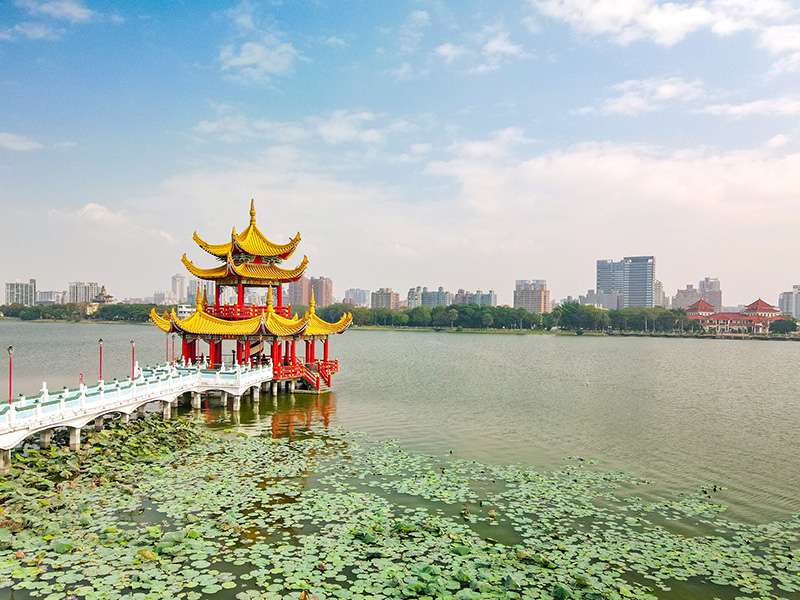Exploring Unique Temple Architecture Around Lotus Pond in Kaohsiung

According to my earlier post, I spent the morning exploring Pier-2 Art Center, strolled along the scenic Hamaxing Harbor area with its striking white bridge, and wandered into Sun Yat-sen University, which sits at the foot of Monkey Mountain. In the afternoon, the next destination on my Kaohsiung adventure was the peaceful and picturesque Lotus Pond.
About Lotus Pond in Kaohsiung
You can get to Lotus Pond by taking the MRT to Ecological District Station, then walking about 30 minutes. It’s a large man-made lake located in Zuoying District, surrounded by temples, pavilions, and local markets. It gets its English name from the lotus flowers that bloom on the water’s surface, enhancing the spiritual atmosphere created by the nearby temples.
For the most vibrant experience, visit between June and September, when the lotus flowers are in full bloom and the weather is relatively dry. Spring is also a great time to visit for temple visits and cultural offerings. I went in November, and while the pond was a tranquil shade of green, there weren’t any lotus flowers in sight!
Lotus Pond is also known for its water sports events. It was one of the venues for the 2009 World Games, and you can still see the archway with the event’s emblem standing today.
Dragon and Tiger Pagodas – Icon of Lotus Pond
You’ll spot the Dragon and Tiger Pagodas from afar—easily the most iconic landmark at Lotus Pond. A zig-zag bridge leads visitors into the two pagodas through the open jaws of the Dragon and the Tiger.
According to local beliefs: entering through the Dragon’s mouth and exiting from the Tiger’s mouth symbolizes turning bad luck into good fortune. The dragon and tiger together represent balance and auspiciousness in Chinese culture.
Each pagoda is seven stories tall and stands majestically on the lake. The zig-zag walkway leading in is actually made up of nine sharp-angled bridges, intentionally designed to prevent evil spirits from rushing straight into the temple—they’d lose momentum and fall off!
When I visited, the area wasn’t too crowded, but since everyone was busy admiring the temples, there weren’t many people around to help take photos. Thankfully, the sturdy pillars on the bridge worked perfectly to prop up my camera for a self-timed shot. Nailed it!

The Spring and Autumn Pavilions
Not far from the Dragon and Tiger Pagodas are the colorful Spring and Autumn Pavilions, a Taoist complex dedicated to Guan Gong, the god of war. The highlight here is a towering statue of Guanyin Bodhisattva riding a dragon, which gives the area a mystical and majestic presence.
The pavilions are connected by turquoise balconies layered on top of golden-yellow floors. They’re situated close to the shore, so they’re easier to reach than some of the other temples around the lake. I didn’t go inside due to the crowd, but admired the architecture from the outside.
There’s also a striking viewing platform nearby that juts out over the lake—although I didn’t catch its name, it definitely caught my eye with its long, sleek design.
Confucius Temple Complex – The Largest in Kaohsiung
Located on the opposite side of the lake is the serene Confucius Temple, the largest of its kind in Taiwan. The temple’s modern religious architecture is modeled after Song Dynasty buildings and features symmetrical elegance and refined details.
I only passed by this temple briefly due to time constraints, but there’s a long bridge near it that crosses the lake. It offers a great view of the temple and leads back toward the direction of MRT Ecological District Station.
As you walk along the edge of Lotus Pond, you’ll come across many more temples and shrines. If you have the time, you could easily spend half a day exploring the area and learning about the fascinating legends behind each structure.
Final Thoughts
Most tourists tend to gather around the Dragon and Tiger Pagodas and the Spring and Autumn Pavilions, while other spots are relatively quiet. So if you’re short on time, just snap a few quick photos at the key spots. But if you do have the luxury of time, I highly recommend finding a peaceful spot by the water to reflect and soak in the unique temple architecture that surrounds Lotus Pond.
